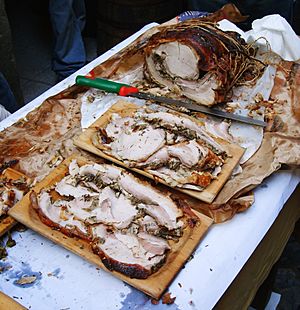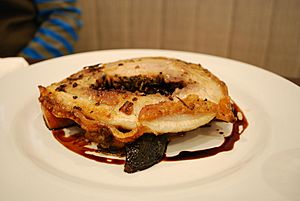Porchetta facts for kids

Porchetta, whole and cut in slices
|
|
| Place of origin | Italy |
|---|---|
| Main ingredients | pork, rosemary, garlic, and pepper |
Porchetta is a super tasty, boneless pork roast from Italy. It's known for being juicy and full of flavor. To make it, a whole pig is deboned. Then, it's carefully stuffed with things like liver, wild fennel, and lots of herbs. The skin and fat are left on, which makes it extra delicious.
Traditionally, porchetta is roasted over wood for at least eight hours. It's seasoned with plenty of salt, garlic, rosemary, fennel, or other wild herbs. The Italian government even recognizes porchetta as a "traditional agricultural-food product." This means it's an important part of Italy's food culture.
Contents
Porchetta's Italian Roots
Porchetta is popular all over Italy, but it first came from central Italy. The town of Ariccia, near Rome, is especially famous for it. In many parts of Italy, porchetta is a special dish for celebrations.
You'll often find porchetta sold by street vendors. They usually have white vans and sell it during public events or holidays. It's commonly served in a panino (a type of sandwich). In Rome and the Lazio region, it's a popular street food. People often eat it as a filling for pizza bianca, which is like a plain pizza bread. It's also a favorite meat dish for family meals or picnics.
Regional Porchetta Flavors
Porchetta is one of the most famous foods from the Lazio region. The other is pecorino romano, a sheep's cheese. Porchetta is also very common in Abruzzo. Porchetta abruzzese is slow-roasted with rosemary, garlic, and pepper.
In Umbria, porchetta is stuffed with chopped pig entrails (organs). These are mixed with lard, garlic, salt, lots of pepper, and wild fennel.
Porchetta from Treviso, called porchetta trevigiana, was first made in 1919. A one-year-old pig is used. Its meat is stuffed with salt, pepper, wild fennel, garlic, and white wine. Then, it's roasted in an oven for seven hours at 90 degrees Celsius (194°F). Today, this porchetta is a popular dish in Venetian cuisine.
The dish is also a main food in Sardinian cuisine. There, it's called "porceddu." It's roasted over fires made with juniper and myrtle wood, which gives it a unique smoky flavor.
Porchetta in North America
Italian immigrants brought porchetta to the United States in the early 1900s. Many of these immigrants were from the Abruzzo region. Sometimes, people call it "Italian pulled pork," "roast pork," or "Italian roast pork." It's often served on a sandwich with green vegetables like rapini or spinach and provolone cheese.
Philadelphia's Famous Roast Pork
In Philadelphia and the areas around it, the dish is usually just called "roast pork" or "roast pork sandwich." It's a very famous part of Philadelphia cuisine. This sandwich is typically served on an Italian roll. It often comes with broccoli rabe and sharp provolone cheese made locally.
"Roast pork" is a key food for Italian-Americans in Philadelphia, especially in South Philadelphia. Restaurants like DiNic's Roast Pork, John's Roast Pork, Esposito's Porchetta, and Tony Luke's are well-known for their porchetta or "roast pork" sandwiches.
Porchetta Traditions in Other Areas
Bridgeport, Connecticut, has a special Saturday afternoon tradition. People enjoy porchetta sandwiches at local restaurants and taverns. This tradition started with the first Italian immigrants in the early 1900s. The dish is often served with pepperoncini (mild chili peppers).
There's even an annual bus tour in Bridgeport, Connecticut, every first Saturday in March. It celebrates the porchetta and roast beef sandwich traditions. It's called The Porchetta Project.
In Metro West Massachusetts, porchetta is also very popular. Local groups often hold Porchetta Dinners to raise money, and these events are very well attended. Many local shops sell porchetta, either cooked or uncooked. Milford and Framingham, Massachusetts, are notable for their large Italian populations and love for porchetta. The spices used can be different in this area. Some use lots of garlic, black pepper, salt, fennel, rosemary, and sage. Others might only use garlic, salt, pepper, and fennel. Sometimes, the stem of the fennel plant is used instead of fennel seeds. These local roasts are made from the pig's shoulder, also known as the Boston butt.
Porchetta is also very popular in Northern Ontario, especially in Sudbury and Sault Ste. Marie. It's also loved in Southern Ontario, in places like Hamilton and St. Catharines. Italian-Canadians often use the term "porchetta" instead of just "roast pork."
Porchetta (sometimes spelled "porketta") is also popular in the Upper Midwest of the U.S. Italian immigrants brought it to the Michigan and Minnesota Iron ranges.
Italian settlers in Sudbury shared their love for porchetta with their families and friends. Old family recipes for spicing, rolling, and roasting porchetta are passed down. This tradition has even grown into butcher shops and fast-food sandwich places. "Porketta Bingo" is a popular Saturday afternoon game in Sudbury. It's like a traditional Canadian "meat draw." Winners get a pound of porchetta and a sourdough bun. The money raised from Porketta Bingo usually goes to local charities or hockey teams.

See also
 In Spanish: Porchetta para niños
In Spanish: Porchetta para niños


